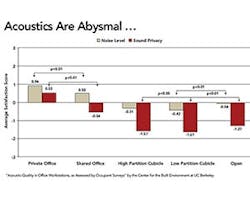Acoustics: The Biggest Complaint in LEED-Certified Office Buildings
Green initiatives and good acoustic design frequently find themselves at odds, but that doesn’t have to be the case. With a little creativity and consideration, you can integrate these two goals and have a facility that is both sustainable and functional.
Workplaces are doing a poor job of providing acoustical comfort in green facilities, according to the January 2012 white paper Sound Matters by the General Services Administration (GSA). Compared to building conditions such as lighting, air quality, and even thermal comfort – which is notoriously dissatisfying – problems with acoustics are the leading source of complaints, the report reads.
Going back to 2005, poor acoustics have caused the greatest dissatisfaction in renovated LEED-certified offices, according to an occupant indoor environmental quality (IEQ) survey of 23,450 respondents from 142 buildings. Conducted by the Center for the Built Environment (CBE) at the University of California, Berkeley, results appear in the report Acoustic Quality in Office Workstations, as Assessed by Occupant Surveys.
Impact of LEED
Initially the LEED credit system was viewed as part of the problem, but it is becoming part of the solution, says Gregory A. Coudriet, acoustical consultant for The Sextant Group, Inc.
“The implementation of many LEED initiatives can unintentionally degrade acoustical performance,” Coudriet says. “Passive cooling systems like radiant flooring and chilled beams can interfere with sound-absorbing ceiling and floor finishes and also remove the masking benefits of traditional HVAC systems. It’s well-known that lowering partition heights for increased daylighting and air flow is problematic.”
However, LEED programs for schools and healthcare were the first to reward points for acoustical design and are paving the way for future programs.
In schools, the aim is to enhance speech intelligibility by meeting the Sound Transmission Class (STC) requirements of ANSI Standard S12.60-2002. For healthcare, the goal is to provide a healing environment free of intrusive or disruptive sounds and is met by achieving sound isolation based on Facility Guidelines Institute (FGI) criteria.
“These points can typically be transferred to other building types if you meet the prescriptive guidelines and show their benefit in your facility,” Coudriet says.
LEED Pilot Credit 24: Acoustics is now open for its third public comment and is applicable to new construction and commercial interiors. It considers room noise level calculations, sound isolation assessment, and speech privacy analysis, among other factors.
Sustainable Acoustic Materials
Material selection is another way to integrate green strategies and acoustic solutions.
“Before, acoustical wall panels were just fabric-wrapped, plain-Jane fiberglass. Now there are formaldehyde-free options or those with no petroleum-based binding chemicals,” says Ethan C. Salter, acoustical consultant at Charles M. Salter Associates, Inc. “Five years ago we didn’t care where or how something is made or if it’s recycled or recyclable. But today we’re aware of that.”
Manufacturers are also producing common acoustic materials like vinyl barriers and rubber isolators in more sustainable ways, Coudriet says.
“Environmentally friendly products do exist, though they’re not always marketed as such,” he explains. “Selecting appropriate solutions often requires research and a consultant familiar with the project’s acoustical and green design requirements.”
RPG Diffusor Systems Inc. developed a Plexiglas sound absorber to put over windows and allow daylight into open, echoing atriums and light wells, Coudriet says.
Mistakes and Misconceptions
Common yet flawed practices also interfere with acoustics and can be costly. A persistent misconception is that wall panels will block voices from the next room over.
“Those are acoustical absorbers and while they keep sound from building up or reverberating in the room, they do very little to stop sound from transmitting,” Coudriet explains. “To block sound, use airwall construction, seals on doors, or an acoustic barrier ceiling.”
Another mistake is eliminating ceiling tiles for material and environmental concerns without considering the acoustical impact, Coudriet adds.
Quieter, more efficient HVAC systems eliminate masking background noise, introducing the library pin-drop effect. “Suddenly you can hear papers rustling 30 feet away,” adds Salter. “That’s when you want to consider a masking system.”
Perhaps the greatest myth is that green initiatives and acoustical design are opposed at all. “It’s easy to say green building and acoustics are at odds or incompatible, but I don’t think that’s the case,” Coudriet says. “They’re intertwined. Look for opportunities to develop solutions that satisfy both.”
“If the building doesn’t work for its occupants – if it isn’t functional – then is it really sustainable?” adds Coudriet. “Green building is all about compromise across systems. Don’t pursue one goal in spite of another.”
Chris Curtland ([email protected]) is assistant editor of BUILDINGS.
